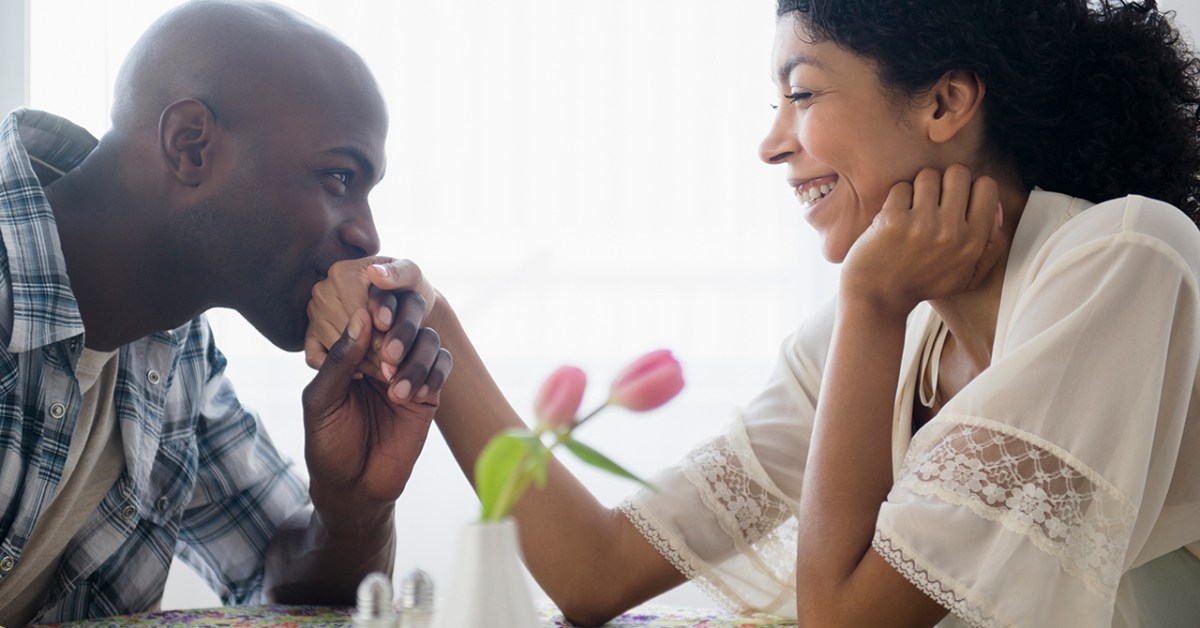
5 facts about relationships and dating in the U.S.
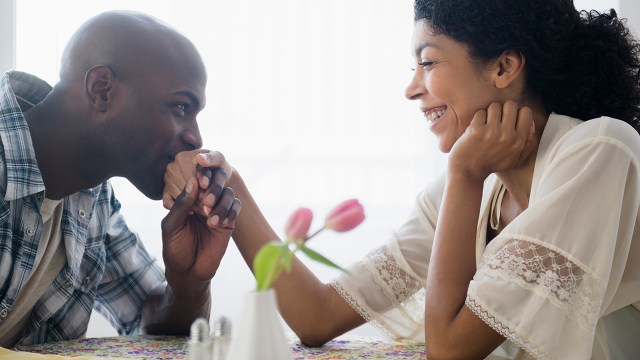
Valentine’s Day this year will be unlike any in recent memory as coronavirus-related restrictions continue to limit what Americans can do to celebrate. But many Americans may still find special ways to mark the holiday with their loved ones or hop on a dating website or app to meet someone new. Here are five facts about relationships and dating in the United States, based mostly on Pew Research Center surveys and analyses conducted before the COVID-19 pandemic.
Pew Research Center conducted these studies as part of its continuing research on marriage and families, personal experiences with and attitudes toward dating and relationships, and the coronavirus outbreak. Most of the findings are based on a survey conducted Oct. 16-28, 2019, among 4,860 U.S. adults. This includes those who took part as members of the Center’s American Trends Panel (ATP), an online survey panel that is recruited through national, random sampling of residential addresses, as well as respondents from the Ipsos KnowledgePanel who indicated that they identify as lesbian, gay or bisexual (LGB).
The finding on relationship satisfaction in 2020 compared with 2019 is based on two surveys: one conducted Oct. 13-19, 2020, among 10,332 U.S. adults and another conducted June 25-July 8, 2019, among 9,834 U.S. adults. All participants were members of the American Trends Panel.
Recruiting ATP panelists by phone or mail ensures that nearly all U.S. adults have a chance of selection. This gives us confidence that any sample can represent the whole U.S. adult population (see our Methods 101 explainer on random sampling). To further ensure that each ATP survey reflects a balanced cross-section of the nation, the data are weighted to match the U.S. adult population by gender, race, ethnicity, partisan affiliation, education and other categories.
Here are the questions used, along with responses, and the methodology for the October 2019 survey, and the questions used, along with responses, and the methodology for the October 2020 survey.
Married and cohabiting adults are just as satisfied with their relationships as they were before the coronavirus outbreak.
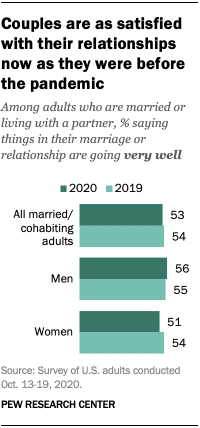
The pandemic has reshaped many aspects of American life, and the relationship and dating landscape is no exception. Still, as of October 2020, adults who were married or living with a partner were just as likely to say they are satisfied with their relationship as they had been before the outbreak.
Despite stay-at-home orders and other pandemic-related restrictions that might have put a strain on many relationships, 53% of married or cohabiting adults said things in their marriage or relationship were going very well in 2020 – virtually unchanged from 54% in 2019.
Three-in-ten Americans had used a dating site or app as of 2019, and most said their experiences were positive. Some 30% of Americans said in October 2019 that they had ever used a dating site or app, though it remains to be seen if and how the coronavirus pandemic has impacted these figures.
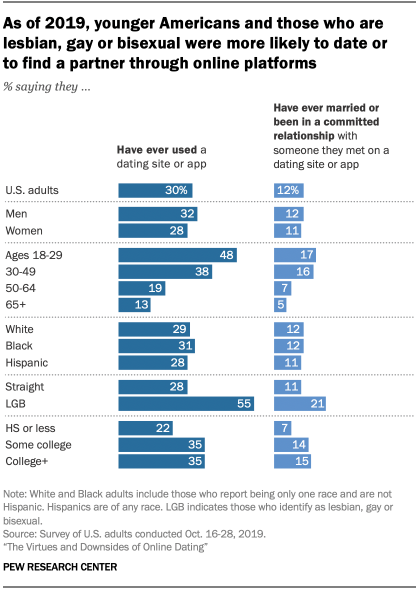
There are some demographic differences in who uses online dating websites or apps, especially along age, sexual orientation and educational lines, according to the 2019 survey. About half (48%) of adults ages 18 to 29 said they had ever used a dating site or app, followed by 38% of adults ages 30 to 49. The shares were substantially smaller for older adults: 19% of adults 50 to 64 and 13% of those 65 and older said they had ever used a dating site or app. When it comes to sexual orientation, lesbian, gay and bisexual (LGB) adults were about twice as likely as straight adults to say they had used a dating site or app (55% vs. 28%).
About six-in-ten online daters said their experience using these sites or apps had been very or somewhat positive, while 42% described their experiences as very or somewhat negative. Majorities of online dating users said it was at least somewhat easy to find people who they were physically attracted to (71%); shared their hobbies and interests (64%); seemed like someone they wanted to meet in person (64%); and were looking for the same kind of relationship (61%).
Single Americans said in 2019 that they were generally open to dating people from a variety of backgrounds, but some characteristics would give them pause.
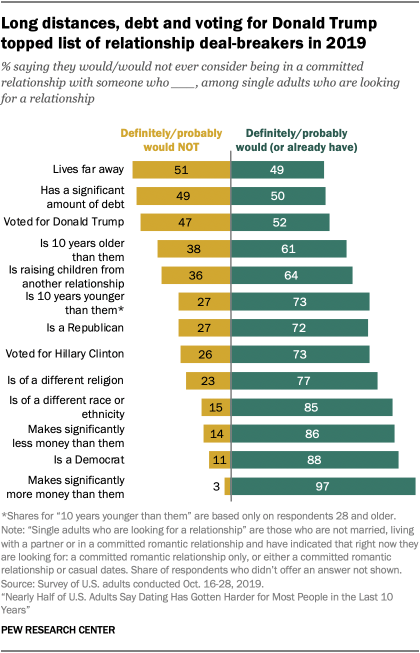
In the 2019 survey, about half of single adults who were looking for a relationship said they would definitely or probably not consider seriously dating someone who lived far away (51%), had a significant amount of debt (49%) or had voted for Donald Trump in 2016 (47%).
Other items on the list of potential relationship deal-breakers included dating someone who was 10 years older (38%) or someone who was raising children from another relationship (36%). But majorities of single adults looking for a relationship were still open to dating someone with these characteristics.
Meanwhile, a significant majority of single adults who were looking for a relationship said they would definitely or probably date someone who was a different race or ethnicity (85%) or a different religion (77%) from them.
Most Americans said in 2019 that premarital and casual sex were at least sometimes acceptable, but sex on a first date and open relationships were seen as more taboo.
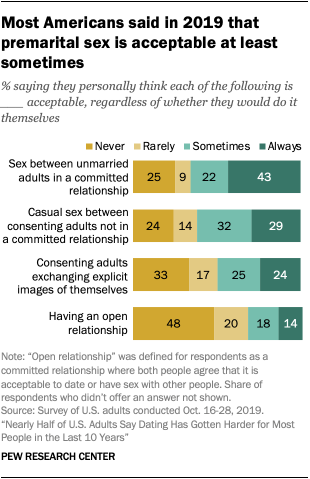
Around two-thirds of adults (65%) said sex between unmarried adults in a committed relationship is sometimes or always acceptable, while a slightly smaller share (62%) said the same about casual sex between consenting adults.
Open relationships – that is, committed relationships where both people agree that it is acceptable to date or have sex with other people – were viewed as the least acceptable behavior of those asked about in the survey, with 68% of adults saying this type of arrangement is rarely or never acceptable. Views on the exchange of explicit images between consenting adults were more evenly divided.
There were differences by sexual orientation in views of these relationship arrangements and behaviors. LGB adults, for example, were significantly more likely than straight adults (61% vs. 29%) to say that having an open relationship is always or sometimes acceptable. They were also more likely than their straight counterparts (74% vs. 47%) to say it is at least sometimes acceptable for two consenting adults to exchange explicit images of themselves. And while majorities of both LGB and straight adults said premarital and casual sex are acceptable, LGB adults were significantly more likely to say this. When it comes to premarital sex, 77% of LGB adults said it was acceptable, compared with 64% of straight adults, and the differences between these groups only increase for casual sex: 86% of LGB adults said it was acceptable, compared with 60% of straight adults.
As of 2019, single Americans ages 65 and older were less likely to be looking to date, but around a quarter had still tried online dating. Three-quarters of singles 65 and older said in 2019 that they were not looking for a date or a committed relationship. These older singles – the vast majority of whom were widowed or divorced – also were less likely than their younger counterparts to say they felt pressure to find a partner. Roughly two-in-ten said they felt pressure from society to be in a relationship (vs. 53% of 18- to 29-year-olds) or pressure from family members (vs. 47% of 18- to 29-year-olds).
Around a quarter (27%) of single Americans ages 65 and up said they had tried online dating at some point. Yet among all partnered adults, only 5% of those 65 and older said they found their spouse or partner online, compared with 21% of partnered adults 18 to 29. It was more common for partnered adults 65 and older to have met their spouse or partner in an offline setting, such as through family or friends (30%), work (20%) or school (15%).
Overall, 36% of Americans ages 65 and older were single in 2019, and among this group, women were much more likely than men to be single (49% vs. 21%).
Note: Here are the questions used, along with responses, and the methodology for the October 2019 survey, and the questions used, along with responses, and the methodology for the October 2020 survey.


